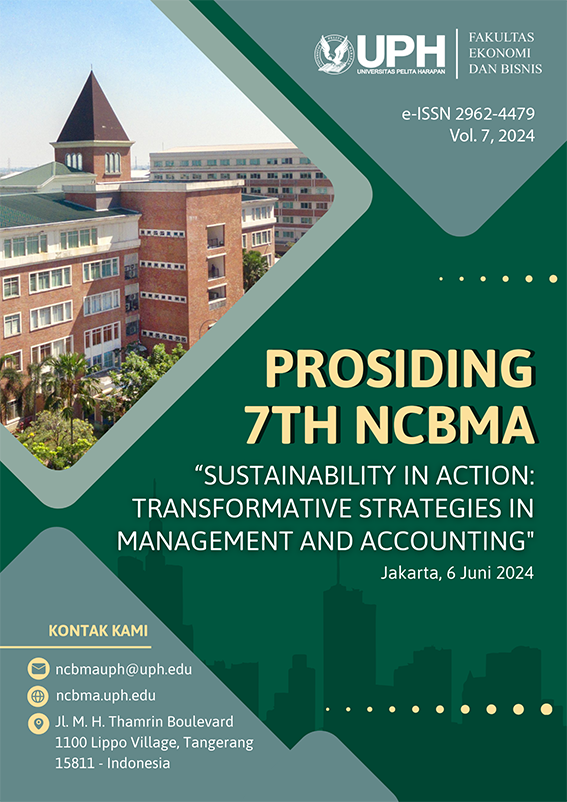QUALITY CULTURE THROUGH THE IMPLEMENTATION OF MBNQA QUALITY MANAGEMENT AND ITS RELATION TO THE COMPANY’S HUMAN CAPITAL PERFORMANCE
Keywords:
Quality Management, Human Capital, Performance, MBNQAAbstract
This study investigates the relationship between the quality culture fostered by implementing MBNQA quality management and human capital performance in one of Indonesia's largest industrial gas companies. One hundred eight employees with a level of management below that of a manager completed the survey questionnaires. Analyzing the relationship between seven variables of quality culture based on the Malcolm Baldrige Criteria for Performance Excellence, namely Leadership, Strategic Planning, Customer Focus, Measurement, Analysis and Knowledge Management, Focus on Manpower, Process Management, and Results, multiple linear regression techniques were employed. The study hypothesizes a statistically significant relationship between Customer Focus, Measurement Analysis and Knowledge Management, Focus on Human Resources, Process Management and Human Capital Performance. The study's findings suggest that the four quality cultures - Customer Focus, Measurement, Analysis, Knowledge Management, Focus on Human Resources, and Process Management - can be utilized effectively within the context of an industrial gas company to improve Human Capital performance. Few studies have examined the relationship between quality culture and the human capital performance of low-level managerial employees at Indonesia Gas Company, so the results are significant.
References
Akio, T. (2005). The Critical Assessment of the Resource Based View of Strategic Management: The Source of Heterogeneity of the Firm. Ritsumeikan International Affairs, 3, 125-150.
Ali, H. M., & Musah, M. B. (2012). Investigation of Malaysian Higher Education Quality Culture and Workforce Performance. Quality Assurance in Education, 20(3), 289-309. https://doi.org/10.1108/09684881211240330
Alotaibi, F., Yusoff, R. Z., & Islam, R. (2013). Assessing the Impact of Total Quality Management Practices and Quality Culture with Competitiveness of Saudi Contractors. American Journal of Applied Sciences, 10(6), 638-645. https://doi.org/10.3844/ajassp.2013.638.645
Bratianu, C., & Pinzaru, F. (2015). University Governance as a Strategic Driving Force University Governance as a Strategic Driving Force. Management Dynamics in the Knowledge Economy, 3(4), 609-627.
Bromiley, P., & Rau, D. (2015). Operations Management and The Resource-Based View : Another View. Journal of Operations Management, 41, 95-106. https://doi.org/10.1016/j.jom.2015.11.003
Cameron, K., & Sine, W. (1999). A Framework for Organizational Quality Culture. Journal of Quality Technology, pp. 7-25.
Cronemyr, P., Bäckström, I., & Rönnbäck, Å. (2017). Quality Culture Deployment - using Behaviours to Explain, Diagnose and Improve a Quality Culture. International Journal of Quality and Service Sciences, 9(3/4), 498-518. https://doi.org/10.1108/IJQSS-02-2017-0008
Deloitte. (2022). 2023 oil and gas industry outlook. Deloitte Development LLC.
Detert, J. R., Schroeder, R. D., & Mauriel, J. J. (2000). A Framework for Linking Culture and Improvement Initiatives in Organizations. Academic of Management Review, 25(4), 850-863. https://doi.org/10.2307/259210
GarcÃa-Fernandez, M., Claver-Cortes, E., & TarÃ, J. J. (2022). Relationships between Quality Management, Innovation and Performance : A Literature Systematic Review. European Research on Management and Business Economics, 28(1-20). https://doi.org/10.1016/j.iedeen.2021.100172
Golshahi, A., Firoziani, E., Estahbanati, F. K. Haghparast, A. A., & Nou, Z. R. (2015). Identifying and Ranking Indicators of Intellectual Capital in Higher Educational Institutions from Perspective of Faculty Members: A Case Study University of S and B. Journal of Scientific Research and Development, 2(3), 169-176.
Ingelsson, P., Bäckström, I., & Wiklund, H. (2010). Measuring the Soft Sides of TQM and Lean. Proceedings of 13th QMOD International Conference, Quality Management & Organisational Development.
ISO. (2015). Quality Management Systems - Requirements of a Quality Management System (ISO 9001:2015). SIS. www.iso.org
Kabue, L. W., & Kilika, J. M. (2016). Firm Resources, Core Competencies and Sustainable Competitive Advantage : An Integrative Theoretical Framework. Journal of Management and Strategy, 7(1), 98-108. https://doi.org/10.5430/jms.v7n1p98
Kotter, J.P. and Heskett, J. L. (1992). Corporate Culture and Performance. MacMillan International.
Lagrosen, Y. (2006). Values and practices of quality management: health implications and organizational differences. Chalmers University of Technology, Göteborg.
Maani, K. E., Putterill, M. S., & Sluti, D. G. (1994). Empirical Analysis of Quality Improvement in Manufacturing. International Journal of Quality & Reliability Management, 11(7), 19-37.
Mangkunegara, A. P. (2005). Evaluasi Kinerja Sumber Daya Manusia. PT. Refika Aditama.
Nahm, A. Y., Vonderembse, M. A., & Koufteros, X. A. (2004). The Impact of Organizational Culture on Time-Based Manufacturing and Performance. Decision Sciences, 35(4), 579-607.
Naor, M., Goldstein, S. M., Linderman, K. W., & Schroeder, R. G. (2008). The Role of Culture as Driver of Quality Management and Performance : Infrastructure Versus Core Quality Practices ˆ—. Decision Sciences, 39(4), 671-702.
Prajogo, D. I., & Mcdermott, C. M. (2005). The relationship between total quality management practices and organizational culture. International Journal of Operations & Production Management, 25(11), 1101-1122. https://doi.org/10.1108/01443570510626916
Riahi-belkaoui, A. (2003). Intellectual Capital and Firm Performance of U.S. Multinational Firms : A Study of the Resource-Based and Stakeholder Views. Journal of Intellectual Capital, 4(2), 215-226. https://doi.org/10.1108/14691930310472839
Rupidara, N. S. (2008). Modal Intelektual dan Strategi Pengembangan Organisasi dan Sumber Daya Manusia. Universitas Kristen Satya Wacana.
Sila, I., & Ebrahimpour, M. (2003). International Journal of Production Examination and Comparison of the Critical Factors of Total Quality Management ( TQM ) Across Countries. International Journal of Production Research, 41(2), 235-268. https://doi.org/10.1080/0020754021000022212
Simamora, H. (2002). Manajemen Sumber Daya Manusia. STIE YKPN.
Simanungkalit, P. P. (2015). Pengaruh Intellectual Capital Terhadap Nilai Perusahaan dengan Kinerja Keuangan sebagai Variabel Intervening (Studi Pada Perusahaan Manufaktur yang Terdaftar di BEI Periode 2009-2013). Diponegoro Journal of Management, 4(3), 1-13.
Soria-garcÃa, J., & MartÃnez-lorente, Ã. R. (2020). The Influence of Culture on Quality Management Practices and Their Effects on Perceived Service Quality by Secondary School Students. Quality Assurance in Education, 28(1), 49-65. https://doi.org/10.1108/QAE-10-2018-0112
Svensson, M., & Klefsjo, B. (2006). TQM-based Self-assessment in the Education Sector: Experiences from a Swedish Upper Secondary School Project. Quality Assurance in Education, 14(4), 299-323. https://doi.org/10.1108/09684880610703929
Tang, Y. (2006). Beyond Behavior : Goals of Cultural Learning in the Second Language Classroom. The Modern Language Journal, 90(1), 86-99.
Wu, S. J. (2015). The impact of quality culture on quality management practices and performance in Chinese manufacturing firms. International Journal of Quality & Reliability Management, 32(8), 799-814. https://doi.org/10.1108/IJQRM-12-2013-0199
Downloads
Published
Issue
Section
License
Copyright (c) 2024 Oliandes Sondakh, Renna Magdalena

This work is licensed under a Creative Commons Attribution-ShareAlike 4.0 International License.

